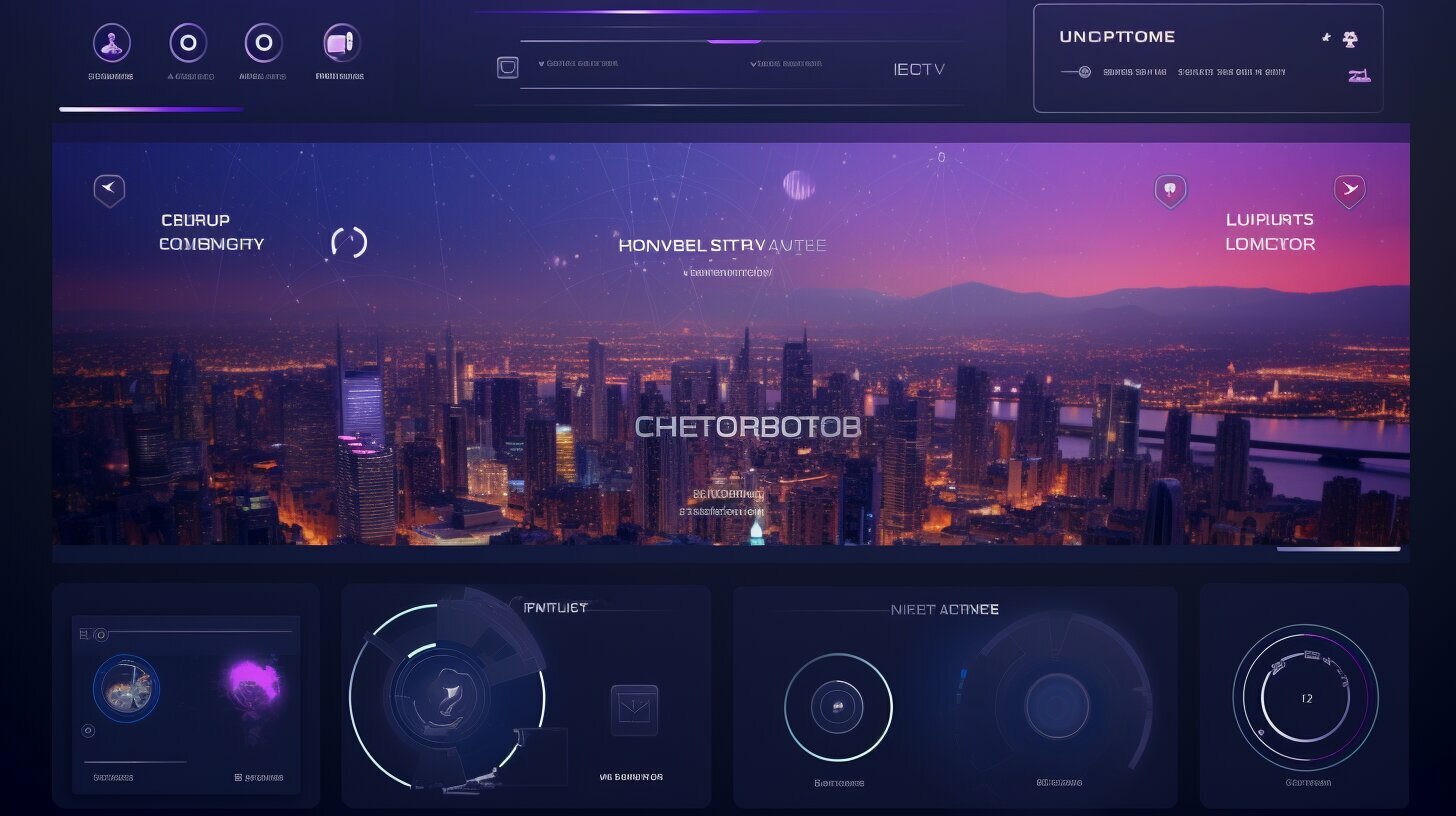The integration of chatbots in digital marketing strategies can revolutionize customer engagement and streamline processes for businesses. Implementing chatbots offers several benefits, including lead generation, enhanced social media engagement, maintaining brand personality, and promoting low-performing products. Chatbots can collect email leads in a less threatening way than web forms, leading to higher conversion rates. They can also boost response time and engagement on social media platforms, resulting in higher open rates and ROI. Additionally, chatbots can provide personalized support, promote products, and notify customers about promotions, ultimately improving online sales and customer service efficiency.
Key Takeaways:
- Implementing chatbots in digital marketing strategies can revolutionize customer engagement and streamline processes.
- Chatbots offer benefits such as lead generation, enhanced social media engagement, maintaining brand personality, and promoting low-performing products.
- Chatbots can collect email leads in a less threatening way, leading to higher conversion rates.
- Chatbots can boost response time and engagement on social media platforms, resulting in higher open rates and ROI.
- Chatbots can provide personalized support, promote products, and notify customers about promotions, improving online sales and customer service efficiency.
Understanding the Benefits of Chatbot Implementation
Integrating chatbots in digital marketing offers a multitude of advantages, ranging from lead generation to enhancing social media engagement. Chatbots can revolutionize the way businesses interact with their customers, providing personalized support and streamlining processes. Let’s explore some key benefits of incorporating chatbots into your marketing strategy:
1. Lead Generation: Chatbots can collect valuable customer information, such as email leads, in a less threatening way compared to web forms. By engaging users in interactive conversations, chatbots can gather data while providing a seamless user experience. This approach not only increases conversion rates but also allows businesses to build a rich database of potential leads.
2. Enhanced Social Media Engagement: Chatbots are a game-changer when it comes to social media engagement. They can respond to customer queries instantly, boosting response time and increasing user engagement. Chatbots can also deliver targeted content and offers, resulting in higher open rates and return on investment for social media campaigns.
3. Maintaining Brand Personality: Chatbots can be programmed to reflect a brand’s tone of voice and persona. This ensures consistent messaging across all customer interactions, creating a cohesive brand experience. By maintaining brand personality, businesses can reinforce their brand image and strengthen customer loyalty.
| Benefits of Chatbot Implementation | Chatbot Integration in Marketing |
|---|---|
| Lead Generation | Collects valuable customer information |
| Enhanced Social Media Engagement | Boosts response time and user engagement |
| Maintaining Brand Personality | Reflects brand’s tone of voice and persona |
By leveraging the benefits of chatbot implementation, businesses can effectively drive lead generation, enhance social media engagement, and maintain a consistent brand identity. A well-executed chatbot strategy can not only streamline customer interactions but also improve online sales and customer service efficiency. Stay tuned for the next section, where we will explore the process of developing a chatbot strategy for your digital marketing campaigns.
Developing a Chatbot Strategy
Creating a successful chatbot strategy requires careful planning and consideration of key elements such as defined goals, target audience, and platform selection. A strategic approach ensures that the chatbot aligns with the overall marketing objectives and effectively engages users.
Defining Goals:
Start by clearly defining the goals you want to achieve with the chatbot. Whether it’s improving customer service, generating leads, or increasing sales, having specific goals will help guide the chatbot’s development and implementation.
Identifying Target Audience:
Understanding your target audience is crucial for designing a chatbot that meets their needs and preferences. Research your target market, identify common pain points, and develop personas to tailor the chatbot’s conversational flow and tone to resonate with your audience.
Selecting the Right Platform:
Choose a chatbot platform that provides the necessary features and integrations to support your marketing strategy. Consider factors such as ease of use, scalability, natural language processing capabilities, and compatibility with your existing systems. Evaluate different platforms and select the one that best suits your requirements.
By developing a comprehensive chatbot strategy, businesses can leverage the power of chatbots to enhance customer engagement, streamline processes, and achieve their digital marketing goals.
Implementation Steps for Chatbots in Digital Marketing
Implementing chatbots in digital marketing campaigns requires a systematic approach that involves selecting the right platform, designing engaging conversations, and seamless integration. By following these implementation steps, businesses can leverage chatbots to enhance customer engagement and drive successful marketing campaigns.
Step 1: Selecting the Right Platform
Choosing the appropriate chatbot platform is crucial for a successful implementation. Consider factors such as ease of use, scalability, customization options, and integration capabilities. Compare different platforms to find the one that aligns with your business needs and objectives.
Step 2: Designing Engaging Conversations
The key to effective chatbot implementation is designing conversational flows that engage users and provide valuable information. Map out different user scenarios and create conversational scripts that guide users through the desired interactions. Use a mix of open-ended and closed-ended questions to gather information and deliver personalized responses.
Step 3: Seamless Integration
Integrating your chatbot with existing systems and platforms is essential for a smooth user experience. Ensure that your chatbot seamlessly integrates with your website, social media channels, customer relationship management (CRM) software, and other relevant tools. This will enable the chatbot to access and retrieve necessary data in real-time, enhancing its ability to provide accurate and personalized responses.
| Benefits of Chatbot Implementation |
|---|
| Lead generation |
| Enhanced social media engagement |
| Maintaining brand personality |
| Promoting low-performing products |
Implementing chatbots in digital marketing campaigns can offer several benefits, such as lead generation, enhanced social media engagement, maintaining brand personality, and promoting low-performing products. Chatbots can collect email leads in a less threatening way compared to web forms, leading to higher conversion rates. They can also boost response time and engagement on social media platforms, resulting in higher open rates and ROI. Additionally, chatbots can provide personalized support, promote products, and notify customers about promotions. By maximizing chatbots in marketing, businesses can improve online sales and customer service efficiency.
Leveraging Chatbots for Lead Generation
Chatbots can play a critical role in lead generation for businesses, offering a less intrusive and more engaging experience for potential customers. By integrating chatbots into their digital marketing strategies, businesses can capture valuable leads and increase conversion rates.
One of the key advantages of using chatbots for lead generation is their ability to collect email leads in a less threatening manner compared to traditional web forms. Chatbots engage users in personalized conversations, making the lead capture process more interactive and conversational. This approach not only increases user engagement but also enhances the overall user experience, leading to higher conversion rates.
Moreover, chatbots are highly effective in qualifying leads by asking relevant questions and gathering information about potential customers’ preferences and needs. This data can be invaluable for businesses in developing targeted marketing campaigns and tailoring their offerings to meet customers’ specific requirements.
| Benefits of Chatbots for Lead Generation |
|---|
| Enhanced user engagement |
| Higher conversion rates |
| Improved lead qualification |
| Personalized user experience |
By leveraging chatbots for lead generation, businesses can streamline their marketing efforts, optimize lead conversion, and ultimately drive business growth. With their ability to engage users in meaningful conversations, collect valuable customer data, and provide personalized experiences, chatbots are a powerful tool for businesses looking to maximize their marketing efforts and generate high-quality leads.
Enhancing Social Media Engagement with Chatbots
Integrating chatbots into social media marketing efforts can significantly enhance engagement levels, foster better customer relationships, and drive higher returns on investment. By leveraging chatbot capabilities, businesses can optimize their social media presence and provide a personalized experience for users.
Improved Response Time and Customer Service
Chatbots enable businesses to respond to customer inquiries and messages in real-time, ensuring a prompt and efficient customer service experience. With automated responses and predefined conversational flows, chatbots can address common queries and provide assistance, even outside of regular business hours. This translates into enhanced customer satisfaction and increased engagement on social media platforms.
Higher Open Rates and ROI
Utilizing chatbots in social media marketing tactics can lead to higher open rates for promotional messages and notifications. Chatbots can deliver personalized messages to users based on their preferences and interaction history, driving higher click-through rates and conversions. Additionally, chatbots can track user behavior and engagement, providing valuable insights for refining marketing strategies and maximizing return on investment.
Seamless User Experience and Interactive Content
Chatbots can deliver interactive content to users on social media platforms, creating a seamless and engaging user experience. They can guide users through quizzes, surveys, and interactive campaigns, collecting valuable data for market research and lead generation. By providing interactive and personalized content, chatbots foster better customer relationships and encourage users to actively participate in brand experiences.
| Benefits of Integrating Chatbots in Social Media Marketing | |
|---|---|
| Improved response time | Higher open rates |
| Efficient customer service | Maximized ROI |
| Seamless user experience | Interactive content |
Personalized Support and Customer Service Efficiency
Chatbots can revolutionize customer support by offering personalized assistance, resolving queries, and streamlining the customer service process. With their ability to understand and respond to customer inquiries in real-time, chatbots provide a convenient and efficient way for businesses to engage with their customers.
By integrating chatbots into their marketing strategies, businesses can ensure that customers receive prompt and accurate responses to their questions and concerns. Chatbots can be programmed to provide personalized recommendations and solutions based on individual customer needs, creating a tailored experience that enhances customer satisfaction and loyalty.
Moreover, chatbots can handle a high volume of customer inquiries simultaneously, reducing the need for customers to wait in long queues or navigate complex phone menus. This not only improves operational efficiency but also enables businesses to provide round-the-clock support, catering to customers in different time zones and enhancing their overall experience.
| Benefits of Chatbots for Personalized Support and Customer Service |
|---|
| 1. Immediate response: Chatbots can provide instant replies to customer inquiries, eliminating the frustration of waiting for a human representative. |
| 2. Consistent service: Chatbots deliver consistent and accurate information, ensuring that customers receive the same level of service every time they interact. |
| 3. 24/7 availability: Chatbots can offer support around the clock, catering to customer needs at any time, including outside of regular business hours. |
| 4. Scalability: Chatbots can handle a large volume of inquiries simultaneously, enabling businesses to scale their support operations without increasing costs. |
In conclusion, integrating chatbots into marketing strategies can significantly improve customer support and service efficiency. By offering personalized assistance, resolving queries promptly, and streamlining the customer service process, chatbots empower businesses to deliver exceptional customer experiences, build brand loyalty, and drive business growth.
Promoting Products and Notifying Customers
Chatbots serve as effective marketing tools, enabling businesses to promote products, offer personalized recommendations, and notify customers about special promotions. With their ability to engage in real-time conversations and provide tailored suggestions, chatbots can enhance the customer experience and drive sales. By leveraging chatbots in digital marketing campaigns, businesses can effectively reach their target audience and achieve their marketing goals.
One way chatbots can promote products is by incorporating them into the customer journey on websites or messaging platforms. For example, when a customer visits an e-commerce website, a chatbot can proactively engage them in a conversation, asking about their preferences and guiding them through the product selection process. By understanding the customer’s needs, the chatbot can recommend relevant products, cross-sell or upsell, and ultimately increase the chances of making a sale.
| Promotion Strategy | Description |
|---|---|
| Personalized Recommendations | Chatbots can analyze customer data and previous interactions to provide personalized product recommendations that align with the customer’s preferences and needs. |
| Flash Sales and Limited-Time Offers | Chatbots can notify customers about exclusive deals, flash sales, or limited-time offers, creating a sense of urgency and encouraging immediate purchases. |
| Abandoned Cart Recovery | Chatbots can remind customers about items left in their shopping carts and offer incentives to complete the purchase, such as discounts or free shipping. |
In addition to promoting products, chatbots can also notify customers about special promotions. Whether it’s a new product launch, upcoming sale, or exclusive event, chatbots can send automated messages to keep customers informed and engaged. By delivering personalized and timely notifications, businesses can generate excitement, increase brand awareness, and drive repeat purchases.
Overall, integrating chatbots into digital marketing campaigns provides businesses with a versatile tool to promote products and engage customers effectively. By leveraging chatbot capabilities, businesses can provide personalized recommendations, offer exclusive promotions, and create a seamless customer experience that ultimately leads to increased sales and customer loyalty.
Measuring Success and Analytics of Chatbot Implementation
Evaluating the success of chatbot implementation requires monitoring key metrics, analyzing user interactions, and leveraging analytics tools to optimize performance. By tracking these metrics, businesses can gain valuable insights into the effectiveness of their chatbot strategies and make data-driven decisions to improve engagement and achieve their marketing goals.
One of the essential metrics to monitor is user engagement, which can be measured through metrics like average session duration, bounce rate, and click-through rate. These metrics provide insights into how users interact with the chatbot and the quality of their experience. By analyzing this data, businesses can identify areas for improvement and make adjustments to enhance user engagement.
Example of User Engagement Metrics:
| Metric | Definition |
|---|---|
| Average Session Duration | The average amount of time users spend interacting with the chatbot during a single session. |
| Bounce Rate | The percentage of users who leave the chatbot without engaging in any meaningful interactions. |
| Click-through Rate | The percentage of users who click on links or call-to-action buttons within the chatbot. |
Another crucial aspect to consider is user satisfaction, which can be measured through sentiment analysis and customer feedback. Sentiment analysis involves analyzing the tone and sentiment of user interactions to assess their overall satisfaction. Gathering customer feedback through surveys or ratings can also provide valuable insights into user satisfaction levels and areas for improvement.
Additionally, businesses should leverage analytics tools that provide in-depth insights into chatbot performance. These tools can track metrics such as user demographics, conversation flow, and conversion rates. By understanding user demographics, businesses can tailor their chatbot strategies to target specific audience segments better. Analyzing conversation flow can help identify bottlenecks or areas where users get stuck, allowing businesses to optimize the chatbot’s dialogue and improve user experience. Lastly, tracking conversion rates can provide insights into the chatbot’s effectiveness in achieving marketing goals, such as generating leads or driving sales.
To summarize, measuring the success of chatbot implementation requires monitoring key metrics, analyzing user interactions, and leveraging analytics tools. By focusing on user engagement, satisfaction, and using analytics data, businesses can continuously optimize their chatbot strategies, improve customer experiences, and drive better results in their digital marketing efforts.
Overcoming Challenges in Chatbot Implementation
While implementing chatbots in digital marketing strategies offers numerous benefits, it is crucial to address and overcome challenges such as training, privacy concerns, and user expectations. Training the chatbot to handle a wide range of queries and providing accurate responses requires careful planning and continuous improvement. It is important to collect and analyze data on user interactions to refine the chatbot’s conversational flows and enhance its performance.
Privacy concerns are another challenge that needs to be addressed during chatbot implementation. Businesses must ensure that the chatbot follows strict privacy protocols to protect users’ personal information. Implementing measures such as encrypted communication and secure data storage can help build trust and confidence among users.
User expectations play a significant role in the success of chatbot implementation. It is essential to set realistic expectations and clearly communicate the capabilities and limitations of the chatbot. Managing user expectations can be achieved through informative and engaging conversations that guide users on how to best interact with the chatbot and the type of queries it can handle effectively.
Training and Maintenance
Training and maintenance are key aspects to consider when overcoming challenges in chatbot implementation. Ongoing training ensures that the chatbot stays updated with the latest information and improves its conversational abilities. Businesses should establish a process for updating the chatbot’s knowledge base and monitoring its performance to identify and address any issues or gaps.
Addressing privacy concerns
To address privacy concerns, businesses can implement privacy policies and procedures, clearly communicate how user data is handled, and obtain consent for data collection and usage. By taking proactive steps to protect user privacy and security, businesses can build trust and confidence in their chatbot services.
Managing user expectations
To effectively manage user expectations, businesses should provide clear information upfront about the chatbot’s capabilities and limitations. This can be done through well-designed conversational flows that guide users on what the chatbot can help with and what it cannot. By setting accurate expectations, businesses can avoid user frustration and ensure a positive user experience with the chatbot.
| Challenges | Solutions |
|---|---|
| Training | Ongoing training and improvement of the chatbot’s conversational abilities. |
| Privacy Concerns | Implementing privacy protocols, encrypted communication, and secure data storage. |
| User Expectations | Setting realistic expectations through informative and engaging conversations. |
Best Practices for Effective Chatbot Integration
Implementing chatbots effectively requires adherence to best practices that ensure seamless integration, personalized experiences, and continuous improvement. By following these key strategies, businesses can leverage the power of chatbots to enhance their digital marketing strategies and drive better results.
1. Design Conversational UI/UX:
Creating a user-friendly and intuitive conversational interface is crucial for chatbot success. Design interactive and engaging chatbot conversations that align with your brand’s tone and style. Use natural language processing to enable chatbots to understand and respond accurately to user queries. Incorporate visual elements like buttons, images, and quick replies to enhance the overall user experience.
2. Personalization:
A personalized chatbot experience can significantly improve user engagement and satisfaction. Utilize user data and preferences to customize chatbot interactions. Offer personalized recommendations, tailored content, and targeted promotions based on user behavior and past interactions. The more personalized the chatbot experience, the more likely users will feel a connection with your brand.
3. Maintain a Brand Voice:
Consistency is key when integrating chatbots into your digital marketing strategy. Ensure that the chatbot’s language and tone align with your brand’s voice and values. This helps in maintaining a cohesive brand experience across all touchpoints. Regularly update your chatbot’s responses to stay up to date with current trends and changes in your industry.
4. Collect and Act on User Feedback:
Monitoring and analyzing user feedback is essential for continuously improving your chatbot’s performance. Collect feedback through surveys, rating systems, or direct user interactions. Analyze this feedback to identify areas for improvement and implement updates accordingly. Regularly iterate on your chatbot’s design and functionality to meet evolving customer needs and preferences.
| Benefits of Effective Chatbot Integration in Marketing |
|---|
| Improved lead generation and higher conversion rates |
| Enhanced social media engagement and higher open rates |
| Personalized customer support and increased efficiency |
| Effective promotion of products and timely notifications |
By implementing these best practices, businesses can harness the full potential of chatbots to optimize their digital marketing efforts. From providing personalized experiences to driving better engagement and sales, chatbots have become an indispensable tool for businesses looking to stay ahead in the digital landscape.
Case Studies and Success Stories of Chatbot Implementation
Explore real-life examples and success stories of businesses that have harnessed the power of chatbot implementation in their digital marketing strategies. These case studies highlight the benefits and outcomes achieved by leveraging chatbots to enhance customer engagement, streamline processes, and drive business growth.
Case Study 1: E-commerce Retailer
An e-commerce retailer implemented a chatbot in their digital marketing campaigns to address customer inquiries, provide personalized assistance, and drive sales. The chatbot effectively handled common queries, assisted customers in finding products, and made tailored recommendations based on individual preferences. This resulted in a significant reduction in customer service response time and a boost in customer satisfaction. The retailer also used the chatbot to notify customers about new products, promotions, and exclusive offers, resulting in increased sales and improved customer loyalty.
Case Study 2: Travel Agency
A travel agency integrated a chatbot into their digital marketing strategy to enhance social media engagement and streamline the booking process. The chatbot was deployed on their social media platforms, allowing customers to inquire about travel destinations, get real-time assistance, and receive personalized travel recommendations. With the chatbot’s ability to respond promptly and provide valuable information, the agency experienced higher user engagement, increased open rates, and improved ROI on social media campaigns. Moreover, the chatbot simplified the booking process by guiding customers through available options, resulting in a higher conversion rate and improved customer satisfaction.
Case Study 3: Financial Institution
A financial institution utilized a chatbot to provide personalized support and promote its range of financial products. The chatbot was integrated into their website and mobile app, offering real-time assistance to customers seeking information about various banking services. By addressing common queries and providing immediate responses, the chatbot significantly reduced the need for human intervention, improving operational efficiency. Additionally, the chatbot proactively promoted new financial products and notified customers about relevant offers, resulting in increased product awareness, higher customer engagement, and improved cross-selling opportunities.
| Business | Chatbot Implementation | Outcomes Achieved |
|---|---|---|
| E-commerce Retailer | Handled customer inquiries, provided personalized assistance, and drove sales | Reduced response time, increased customer satisfaction, and improved sales |
| Travel Agency | Enhanced social media engagement and streamlined the booking process | Improved user engagement, increased open rates, and higher conversion rates |
| Financial Institution | Provided personalized support and promoted financial products | Improved operational efficiency, increased product awareness, and enhanced customer engagement |
Conclusion
In conclusion, integrating chatbots into digital marketing strategies can revolutionize customer engagement, streamline processes, and contribute to overall business success. By implementing chatbots, businesses can harness the benefits of lead generation, enhanced social media engagement, maintaining brand personality, and promoting low-performing products.
One of the key advantages of chatbot implementation is the ability to collect email leads in a less intrusive manner compared to web forms. This approach leads to higher conversion rates and enables businesses to build a qualified customer database for future marketing campaigns.
Furthermore, chatbots can significantly improve response time and engagement on social media platforms. With their automated and personalized messaging capabilities, chatbots can provide timely information, increase user interaction, and ultimately achieve higher open rates and return on investment on social media marketing efforts.
In addition to customer engagement, chatbots can also enhance personalized support and customer service efficiency. By offering real-time assistance, resolving common queries, and providing quick resolutions, chatbots ensure optimal customer experience and satisfaction, leading to increased customer loyalty and brand reputation.
Lastly, integrating chatbots into digital marketing strategies allows businesses to promote products and notify customers about promotions effectively. Chatbots can be leveraged to drive product awareness, increase sales, and keep customers informed of relevant offers, resulting in improved online sales and customer retention.
In summary, incorporating chatbots into digital marketing strategies is an innovative and powerful way for businesses to interact with customers, optimize processes, and drive growth. With their ability to automate tasks, provide personalized experiences, and deliver immediate responses, chatbots have emerged as a valuable tool for enhancing customer engagement and boosting overall business success in today’s digital landscape.
FAQ
Q: What are the benefits of implementing chatbots in digital marketing strategies?
A: Implementing chatbots in digital marketing strategies can offer several benefits, such as lead generation, enhanced social media engagement, maintaining brand personality, and promoting low-performing products.
Q: How can chatbots improve lead generation?
A: Chatbots can collect email leads in a less threatening way compared to web forms, leading to higher conversion rates.
Q: How can chatbots enhance social media engagement?
A: Chatbots can boost response time and engagement on social media platforms, resulting in higher open rates and ROI.
Q: Can chatbots provide personalized support?
A: Yes, chatbots can provide personalized support by offering real-time assistance, resolving common queries, and providing quick resolutions to ensure customer satisfaction.
Q: How can chatbots promote products and notify customers?
A: Chatbots can be used to promote products and notify customers about promotions, driving product awareness, increasing sales, and keeping customers updated with relevant offers.
Q: How can the success of chatbot implementation be measured?
A: Measuring the success of chatbot implementation can be done through key metrics, tools, and strategies for tracking chatbot interactions, user satisfaction, and overall effectiveness.
Q: What are some common challenges in chatbot implementation?
A: Common challenges in chatbot implementation include ensuring proper training and maintenance, addressing privacy concerns, and managing user expectations.
Q: What are some best practices for effective chatbot integration?
A: Key best practices for effective chatbot integration include designing conversational UI/UX, personalizing interactions, maintaining a brand voice, and constantly improving through user feedback.
Q: Are there any case studies or success stories of chatbot implementation?
A: Yes, there are case studies and success stories of businesses that have successfully implemented chatbots in their digital marketing strategies, showcasing the benefits and outcomes achieved.







